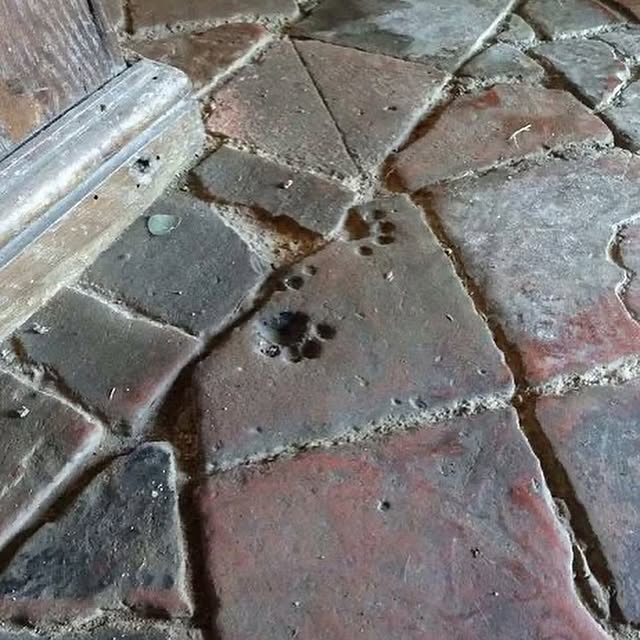In a Quiet English Church, a Cat Once Walked Across Wet Clay—and Its Paw Prints Still Whisper Through Time
Some stories don’t come from books. They come from the floor beneath our feet.
Tucked away in the peaceful English countryside, St. Peter’s Church in Wormleighton stands like many old churches do—silent, ancient, steady. Built in the 12th century, it has seen wars, weddings, births, funerals, plagues, and prayers. Generations have passed through its doors. But one of its most enduring pieces of history doesn’t sit in stained glass or carved stone. It’s in the floor. And it came from a cat.
Yes, a real cat. A curious one. Possibly a little mischievous. Maybe even a little sleepy. We’ll never know its name or color or where it went after that moment. But what we do know is this: sometime over 800 years ago, while workers were shaping and drying clay tiles to be fired for the church’s floor, this little cat wandered across them. Its paws pressed softly into the wet clay—four perfect prints frozen in time.
Most likely, the tiles were left to dry in the open. This wasn’t a modern-day factory. It was a medieval village, where animals and people lived side by side. Cats were welcomed in places like workshops and churches. They kept rodents away, prowled freely, and often went unnoticed. This one, however, left something behind.
Once the prints were made, the workers either didn’t notice—or maybe they did, and simply didn’t care. The tile was fired in the kiln, hardened into red stone, and eventually laid into the church floor, where it would sit unnoticed for centuries.
Generations of villagers walked across it. Children ran over it. Priests, farmers, knights, and nobles may have stood on it without ever realizing that a cat had gotten there first.

When History Feels Alive Beneath Your Feet
The discovery of the paw prints wasn’t really a “discovery” in the dramatic sense. It wasn’t buried treasure or a secret chamber. It was something subtle—a quiet detail noticed by someone looking closely, maybe while cleaning or visiting the church. Someone looked down, paused, and saw not just old stone—but life.
Since then, the paw prints have fascinated both locals and visitors. Social media gave the image wings, and people from around the world have shared it with captions like “This cat lives rent-free in my head” or “Time traveler cat.” It hit people emotionally. There’s something about it that makes history feel less like dates and more like real moments.
Because this isn’t just about a cat walking over clay. It’s about a snapshot of life. It’s about realizing that 800 years ago, people weren’t that different. They had pets. They left things half-finished. They laughed, got frustrated, made mistakes, and kept going. The same way a modern-day builder might groan if a dog ran across freshly poured concrete, someone in the 12th century might’ve muttered something under their breath when they saw those prints—but then just carried on.
That’s what makes this special. It’s not the mistake. It’s the fact that the mistake became part of the story.
Even more beautiful is how fragile it feels. A tile like this could’ve cracked. It could’ve been replaced. It could’ve been buried or lost to time. But somehow, it stayed. Quietly, patiently, just waiting for someone to notice. And when they finally did, the world smiled.
There are other places where this has happened too—medieval cat prints have been found in ancient manuscripts, pottery, and other clay tiles across Europe. One famous example is a 15th-century book from Germany that has ink smudges caused by a cat walking across the open pages. Again, the cat left its mark. And again, it made people laugh centuries later.
In a way, these aren’t accidents. They’re tiny reminders that life doesn’t care about perfect timing. That sometimes, the most human parts of history are the unplanned ones.
So if you ever visit St. Peter’s Church in Wormleighton, look down. Don’t rush past the floor like it’s just stone. Because under your feet is proof that long before we tried to preserve history — a cat wandered into it and made itself comfortable.
And that small, soft, four-pawed interruption has outlived kings.

Daniel Reed is a curious mind with a passion for breaking down how the world works. With a background in mechanical engineering and digital media, he turns complex ideas into easy-to-understand articles that entertain and inform. From vintage tools and modern tech to viral internet debates and life hacks, Daniel is always on the hunt for the “why” behind the everyday. His goal is simple: make learning feel like scrolling through your favorite feed — addictive, surprising, and fun.